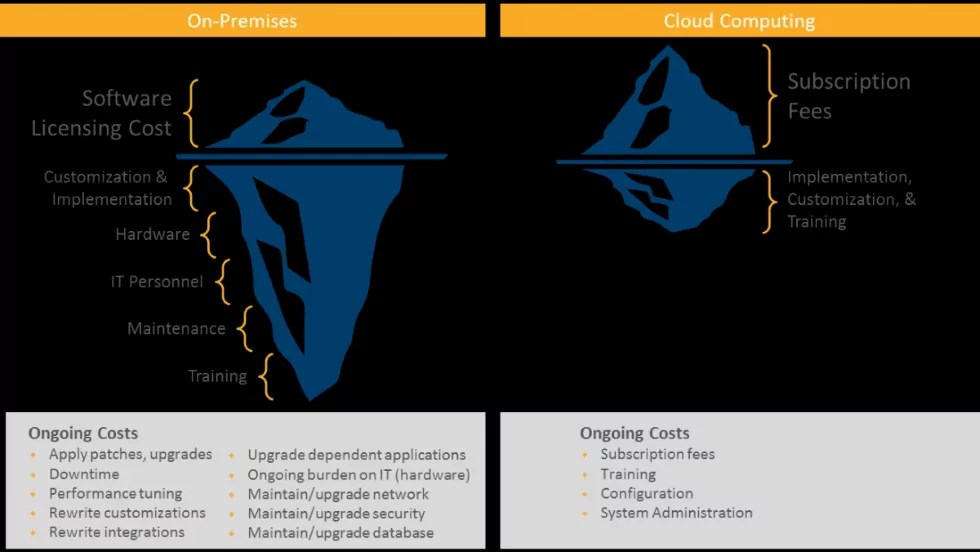Now that you’ve decided to implement an enterprise resource planning (ERP) system, you’re likely trying to determine whether to select an on-premise or cloud-based solution and figure out the costs associated with each.
The start-up costs of a cloud ERP are lower than an on-premise system because with cloud computing you don’t have to buy, deploy and maintain IT assets, which also cuts down on the number of skilled IT workers you need.
The big selling point of cloud services is that the cloud vendor is responsible for all the necessary servers as well as related software and infrastructure. With a cloud deployment model, you can access your ERP from anywhere on any device via the web.
“Gartner Research underscores the total cost of ownership (TCO) advantages by estimating that the annual cost of owning and managing software applications can be as much as four times the cost of the initial purchase,” notes an article in Cloud Strategy Magazine.
Although comparing on-premises and cloud systems, including ERP, is not an apples-to-apples comparison . . . “the inevitable conclusion” favors the cloud as the more cost-effective solution for an organization of any size, according to the article.
Studies have been done on the advantages of the cloud for a number of years. In fact, in 2009, Hurwitz & Associates published a study that compared the TCO of a cloud-based application with a comparable on-premise system.
Even in the early days of the cloud, Hurwitz & Associates found that cloud services “yielded substantial economies of scale and skill and lower TCO,” according to Cloud Strategy Magazine.
“Cloud computing essentially eliminates the need for customers to buy, deploy and maintain IT infrastructure or application software individually, “according to the Hurwitz report. “Regardless of the application, the cloud computing vendor takes responsibility for all of the infrastructure required to run the solution–servers, backup, software, operating systems, databases, updates, migration, power and cooling, facility space, etc., and associated internal and third-party staffing costs.”
Other findings of the Hurwitz report include:
- The overall TCO for a cloud-based integrated solution suite is significantly lower than a comparable on-premise solution.
- IT infrastructure costs (hardware, software, and maintenance) account for about 10% of the total cost of deploying on-premise business systems – costs companies don’t have to incur with cloud-based systems.
- The costs for internal IT staff and/or value-added reseller, consultant, or systems integrator resources required to implement and support a cloud-based system are lower than the total costs for an on-premise solution.
- In a cloud computing model, the front and back office functionality of the business app are integrated, reducing the integration complexity and lowering the cost to implement the system.
And what Hurwitz & Associates found in 2009 is still true today, the article points out. According to Gartner Inc., the amount IT will spend on cloud services this year is $114 billion, and will increase to $216 billion in the year 2020.
This growth rate is mainly due to the cloud’s TCO and its ability to eliminate the ongoing operational costs of internal IT departments and ensure organizations can always take advantage of the latest features and innovations of an application, according to Cloud Strategy.
“A big part of eliminating the ongoing operational costs is retiring capital assets and their associated services,” the article notes. This includes: hardware and software purchases; professional services administered by third-party vendors; software maintenance and upgrades; and contract negotiations and new licenses.
“Perhaps one of the most powerful motivators in the cloud TCO consideration is this: Should IT personnel be consumed with application and hardware maintenance or should they be devoting their time to innovation and R&D?” the article asks.
When you look at it this way, you don’t need a mathematical formula or industry analyst’s statistic to figure out the right answer – “cloud services win,” according to the article.
About ADEACA
ADEACA is a specialized Microsoft industry partner, focused primarily on the research and development of new business processes and ERP software for project-based companies. ADEACA is Microsoft’s go-to partner for project-driven industries, fulfilling Microsoft’s mission to digitally transform businesses by reinventing productivity and business processes for these companies.
Representing Microsoft in project-centric industries, we reconstruct and refine Microsoft’s cloud ERP – Dynamics 365 for Operations to empower and enable businesses to not only adapt to the Real-Time Economy, but drive it.
Featured image from West Monroe Partners, June 30, 2016, https://blog.westmonroepartners.com/rain-down-cost-savings-with-cloud-based-business-applications/







